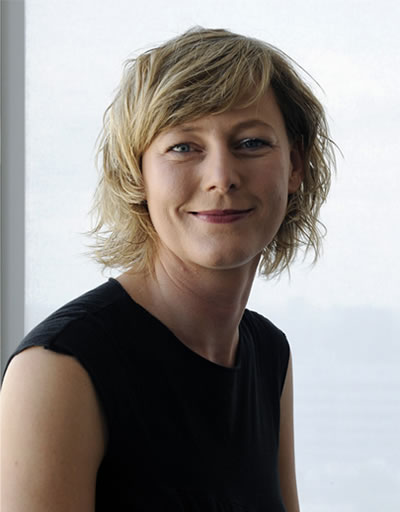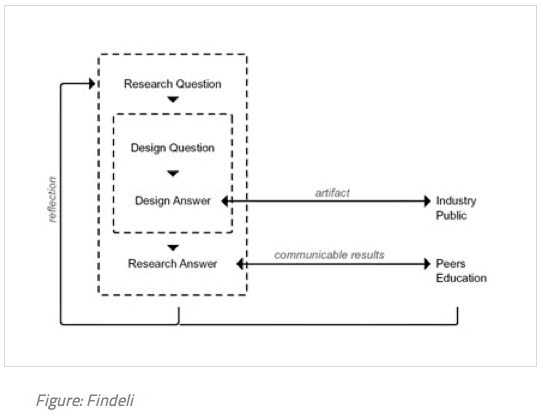编者按:为了介绍“设计研究”(Design Research)的学术动态,促进风景园林学设计理论的发展,“风景园林新青年”联合《风景园林》学刊对“设计研究”领域的国际知名专家学者进行了邮件 访谈,在访谈中针对“设计研究”的一些基本概念和问题,根据各位专家各自的学术特长进行了针对性的交流。希望通过这些访谈的成果,我们能够向读者介绍“设 计研究”的概念,并逐渐推动“设计研究”尤其是“通过设计的研究”(Research through Design)在风景园林学领域内的发展。
本文系“风景园林新青年”与《风景园林》杂志联合刊出

Prof. Gesche Joost
Gesche Joost博士是柏林工业大学交互设计和传媒学系的一名副教授,从2005年开始领导柏林工大的附属机构──德国电信实验室的设计研究实验室。她管理着一个包括20名成员的团队,并作为一名科学家负责德国电信中央创新部的设计研究。她联合柏林工业大学和国际高校共同发展研究及教学项目。她同时作为访问教授在希尔德斯海姆教授“性别与设计”的课程。 此外,她主持了包括人机触觉交互项目在内的多个研究项目。她最近出版了《图像语言:电影的视听修辞》以及《作为修辞的设计》。
一般来说,怎样在通过设计做研究的方法下实施研究项目?
Alain Findeli 非常准确地描述了如何做到这种研究。
非常重要的是要理解设计实践“Entwurf”的过程是此类研究项目中的固有部分。
有些设计研究项目源于一个设计问题──比如我们曾经有过如何为女性设计一款手机的问题。
如果你不想陷入诸如“缩小尺寸,粉饰外观”这类思维定式的方案中,那么你可能会深入到更加基础的层面──提出在信息和通信技术的发展中如何包含性别因素的问题。这其实已经是一个研究问题了。
在“通过设计做研究”的过程中,你可能会在研究和设计之间来回反复──而且你会通过实际的设计来应对你的设计问题。
你有可能会将自己的研究假设在一幅草图中进行视觉化,或者建造一个产品原型来详细地推敲某个主要设想。
你也有可能应用因设计而异的研究工具和过程──可视化分析,符号,文化探针,诸如此类。最重要的是要理解研究和实践之间的互相依赖关系并发掘使两者相协同的你个人的方法。

“通过设计做研究”能为我们提供什么样的设计知识?
很遗憾地说,“通过设计做研究”的过程尚未完善地建立──与其说它是一种现成的研究实践,不如说它是种描述设计研究的理论模型。
因此,我们会从其中获得什么类型的知识,与我们自己领域之外的关系是什么都仍未可知。
可能成为现实的是,“通过设计做研究”和设计研究能挑战当今现有的科学求知概念,并新增一个新的知识领域。
根据我自身的经历,我认为“通过设计做研究”的成果大致说来有两方面:第一是作为设计实践成果的制成产品、产品模型、人工制品。这可能“仅仅”是一种试探或者概念模型,但是它也可以是市场化的产品。另一方面是通过研究过程获得的科学知识──并且是会被语言化或视觉化的,通过学界共享,并接受评价的。
是否可能将现有的“通过设计做研究”的经验应用到风景园林设计领域中来?为什么?
我想是可以的。在我与风景园林专业的同事们的交谈中, 我能感到一种印象,那就是我们有相同的核心要素──“Entwurf”或者称作实际的设计。我们都通过相同的方法表达思想和概念──通过草图,图示,模型,产品原型。有时我们有不同的方式方法,经常是不同的主题,但是这种情况不是主要问题。在我们考虑问题的方法和表达未来的解决方案的方法方面存在着更多的相同性。这些相同性让我觉得我们可以超越不同领域,很好地应用相同的研究模型。
Prof. Dr. Gesche Joost is a Junior Professor for the Interaction Design & Media department at Technische Universität Berlin (TU Berlin), and since 2005 she has headed the Design Research Lab at Deutsche Telekom Laboratories, an institute affiliated with TU Berlin. She manages a team of 20 staff, and as a scientist, she is responsible for design research in the central Innovation department of Deutsche Telekom. She develops research and teaching projects jointly with international universities and Technische Universität Berlin. She also taught the subject “Gender and Design” as a visiting professor in Hildesheim. Furthermore, she leads several research projects, including a project on the topic of tactile human/computer interaction. She recently published “Bild-Sprache. Die audio-visuelle Rhetorik des Films” [Picture language. The audio-visual rhetoric of film] as well as “Design als Rhetorik” [Design as rhetoric].
Generally speaking, how to process a research project with the methodology of research through design (RTD)?
Alain Findeli describes quite precisely how this can be managed.
It is important to understand the process – that the practical design, the “Entwurf”, is an inherent part of the research project as such.
Some of the design research projects start with a design question – we had e.g. the question of how to design a mobile phone for women.
If you don`t want to be trapped in stereotypical solutions like “shrink it and pink it” you might then come to a more fundamental level – asking the question of how to include gender aspects in the development of Information and communication technologies. And this is already a research question.
Within the RtD process, you might go back and forth between research and design – and you will try to tackle your research questions through your practical design.
You might try to visualize your research hypothesis in a sketch, or build a prototype to have a detailed view on one of your main assumptions.
You might also include design-specific research tool and processes – like analytical visualizations, notations, Cultural Probes, or alike. Most important is to understand the interdependencies between research and practice and to find your individual way how to combine both in a synergetic way.
What kind of design knowledge can we gain from RTD?
RtD processes are not very well established yet – it is more a theoretical model to describe design research than an existing research practice – unfortunately.
Therefore, it is still an open question what kind of knowledge we will gain from it – and what relevance it may have beyond our own discipline.
It might become true that RtD and Design Research challenges today’s established concept of scientific inquiry – and add a new category.
From my own experience I can say that the results from RtD are generally speaking twofold: one is the product / prototype / artefact that is the result from design practice. This might be “just” a study or conceptual model, but it can also be a marketable product. The other is scientific knowledge that is gained from the research process – and this will be verbalized or visualized, shared with the community and evaluated by them.
Is it possible to make existing RTD experience applicable in the field of landscape architecture designing? and why?
I think so. Talking to my colleagues from landscape architecture I got the impression that we share the same core element – the “Entwurf” or practical design. We express our thoughts and concepts through this – in a sketch, a diagram, a model, a prototype. Sometimes we have different methods and approaches, often quite different topics – but this is not a main issue. There are more communality in how we think about a problem and how we project different solutions into the future – and this makes me think that we might very well share the same research models throughout the disciplines.
设计研究一系列的文章,编辑用心良苦,挺好。
不过似乎大家好像回复挺少的,记得我宿舍的包同学毕业论文时好像写的是设计方法研究相关的,答辩时王向荣老师好像说,他认为没啥所谓的科学设计方法,每个人有自己不同的思考路子。
其实,究竟有没有已经不是很重要了。我不才个人认为,多看多想多做这6个字如果做到,方法论上就已经够了。
作为设计实践,每个设计师都有自己的工作方法,确实不存在统一的科学设计方法。但是不同设计师的不同设计方法背后有共通的设计思维。这种设计思维让设计师的思想和行为特点不同于艺术家,不同于科学家。在这种设计思维的基础上进行研究工作需要不同于科学思维的或者人文学科思维的方法论。这种方法论到底是什么?正是这一系列访谈中大家在探讨的“通过设计做研究”(RtD)的方法论。风景园林作为一个“一级学科”,与“物理”、“化学”这样的一级学科比较,我们有实践,但是缺少基础理论。不是因为我们没有基础理论,而是我们没有做足够的努力把自己一直以来应用的方法进行总结和梳理。不进行方法论和更加基础的研究方法的总结会导致一个问题,就是这个学科产生的知识会缺少一个学术上公认的标准,这个学科的研究成果会难以跨越学科与其他领域进行交流,进而会导致学科成立的基础产生动摇。而设计师独特的思维和行为,在科学主义主导的学术环境下给跨越学科进行知识的交流带来了一定困难,从更宏观的“人类知识”体系的高度看,厘清设计学科内进行研究、产生知识的机制是为了让设计学科并驾于其他科学学科,既保持设计师多样的工作方法和独特的思维和行为,又保证产生与其他科学学科等标准的、可交流的知识结果。
贤弟所言极是。
学术研究是一种纯学理性的探索,从实践主义、功利主义的立场也许一时看不到什么用处,但从纯学理、从整个知识框架体系的角度来看待,设计方法论研究却是不可或缺的。
所以,在下表示深深的支持。
谢谢支持!这也只是一家之言,还需要更多的人来多批评,多探讨。很喜欢和老哥讨论,很多思想是在讨论中逐渐清晰的。
呵呵,我一直就是试图以大众的眼光实践的眼光看园林。
不过,最终才发现自己毕竟还是无法脱离学院派的影子————在于真正的实践派相比较之后。。。
但一切的理论,最终必须指向实践。
共勉。